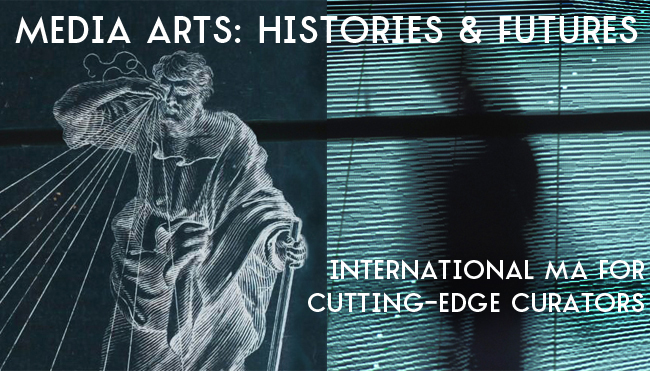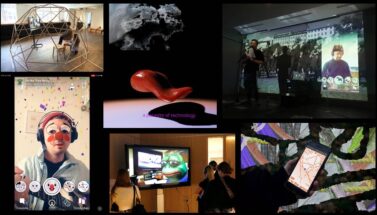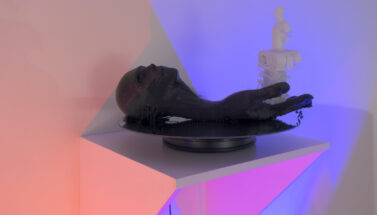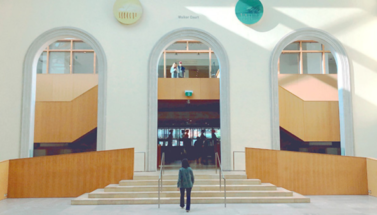Media Arts: Histories and Futures

International low-residency Master of Arts for cutting-edge curators
The only international Master of Arts program focused on preparing art professionals and researchers through a deep exploration of the diverse histories of Media Art, Science and Technology. An interdisciplinary field at the intersection of digital technology and humanities disciplines, MediaArtHistories examines the knowledge frontiers of new media, digital, and electronic art. It addresses the scientific discovery and technological innovation that emerge as part of these art practices and productions, as well as the genealogies of their historical development and context. At a time when digital technologies are fundamentally revolutionizing the very ways in which we communicate, interact, and perceive images, the MediaArtHistories program trains students from diverse backgrounds to critically analyze the visual media cultures of today.
The program is a two-year low-residency, either 90 or 120 ECTS Master degree offered in English. In addition to individual study and project work at your home location, students gather 2-3 times a year for intense seminar modules with internationally renowned media artists and scholars. These enriching sessions take place at Danube University or another European location relevant to the community of media art, such as Linz, Austria as well as Karlsruhe and Berlin, Germany.
Since its beginnings in 2006, Danube University’s prestigious MediaArtHistories MA has offered its students both a deeper critical comprehension and a practical orientation regarding the most important developments of this most contemporary art, by building on its faculty network of renowned international theorists, artists, and curators. These faculty come from across the globe to give seminars during the modules held at Danube University, and from their home universities maintain through online network and project collaboration individualized instruction with students throughout the program. www.mediacultures.net/mah
BRAIN TRUST
MediaArtHistories program faculty include: Irina ARISTARKHOVA, Andreas BROECKMANN, Sean CUBITT, Oliver GRAU, Monika FLEISCHMANN, Darko FRITZ, Jens HAUSER, Kathy Rae HUFFMAN, Erkki HUHTAMO, KNOWBOTIC RESEARCH, Machiko KUSAHARA, Andreas LANGE, Martina LEEKER, Christopher LINDINGER, Wolf LIESER, Roger MALINA, Lev MANOVICH, Nat MULLER, Gunalan NADARAJAN, Frieder NAKE, Jussi PARIKKA, Christiane PAUL, Ana PERAICA, Margit ROSEN, Christopher SALTER, Paul SERMON, Edward SHANKEN, Jeffrey SHAW, Christa SOMMERER, Morten SONDERGAARD, UBERMORGEN, and others.
CONTENT
Courses cover Media Art genres such as Net, Telematic and Genetic Art as well as the most recent reflections on Nano, Bio and Transgenic Art, Video Games, Computer Graphics and Animation, Virtual Reality, Augmented Reality, and Intelligent Environments, Hacktivism and Tactical Media, Performance, Glitch Art, hybrid art and Robotics. MediaArtHistories offers a basis for understanding the evolutionary history of media, from historic examples such as the Laterna Magica and Mechanical Automaton of the 17th century, to computer art at the earliest stages of the Internet in the mid-Twentieth Century and the algorithmic art of today. Explored in depth are key methods and theory from Digital Humanities, Image Science, Media Archaeology, Sound Studies, the Intellectual History of Science & Technology, and Digital Gender Theory. Excursions, and on site faculty seminars, introduce students to the main cultural heritage institutions in the field, such as Ars Electronica and ZKM, archives such as the Archive of Digital Art (ADA www.digitalartarchive.at), festivals such as Transmediale, and the Media Art market.
STUDY in EUROPE
the low-residency modules allow working professionals to maintain their usual employment, and students entering directly after a Bachelor degree will have opportunity to gain valuable career experience while they study. Students are eligible for student visas for year-round residency, enabling parallel pursuit of a research project with the Archive of Digital Art or digitized Graphic Art Collection of nearby Göttweig Abbey, both developed by Danube University, or other opportunities for internships within the MediaArtHistories network. Portions of the Modules take place at the Center for Image Science housed at the Göttweig Abbey. The Danube University is located in the UNESCO World Cultural Heritage “WACHAU” and offers a spectacular backdrop for learning and living.
The Department for Image Science holds important resources of the field like the largest international archive of digital art: www.digitalartarchive.at and the MediaArtHistories Conference Archive www.mediaarthistory.org/maharchive
STUDENTS
International students to our program have come from locations including Austria, Brazil, Canada, China, Egypt, Germany, Iceland, Japan, Korea, Mexico, Russia, Spain, Ukraine, and USA. Alumni of the program are employed not only as freelance curators, creative designers or working artists, but also at renowned cultural sector institutions like: Austrian National Library, Süddeutsche Zeitung, Chicago Art Institute, Deutsche Kinemathek, ETH Zürich, Ars Electronica, ITAU Cultural, Nicolaus Copernicus Universtiy, Pinchuk Art Centre, Hive Advertising, imai, Polytechnic Museum – Moscow, and more. www.donau-uni.ac.at/mahstudents
MODULES: May 1-5, 2017 / Sept 15-25, 2017/ Dec 1-10, 2017 / May 1-5, 2018 / October 1-10, 2018
INTERNSHIP: (MAH-Advanced only) between May -Dec 2018
MASTER THESIS: Nov 2018 – April 2019
APPLICATION (digital) and FUNDING POSSIBILITIES
Acceptance into the program requires either a Bachelor degree (or higher), or equivalent relevant work experience. Requirements: application form, letter of motivation, copies of previous degree(s) or employment validation, copy of passport and Europass CV. An application interview is required, which may be conducted in person or through internet videoconferencing. Resources for funding possibilities and estimated costs:
Application Form
Resources for funding possibilities and estimated costs:




